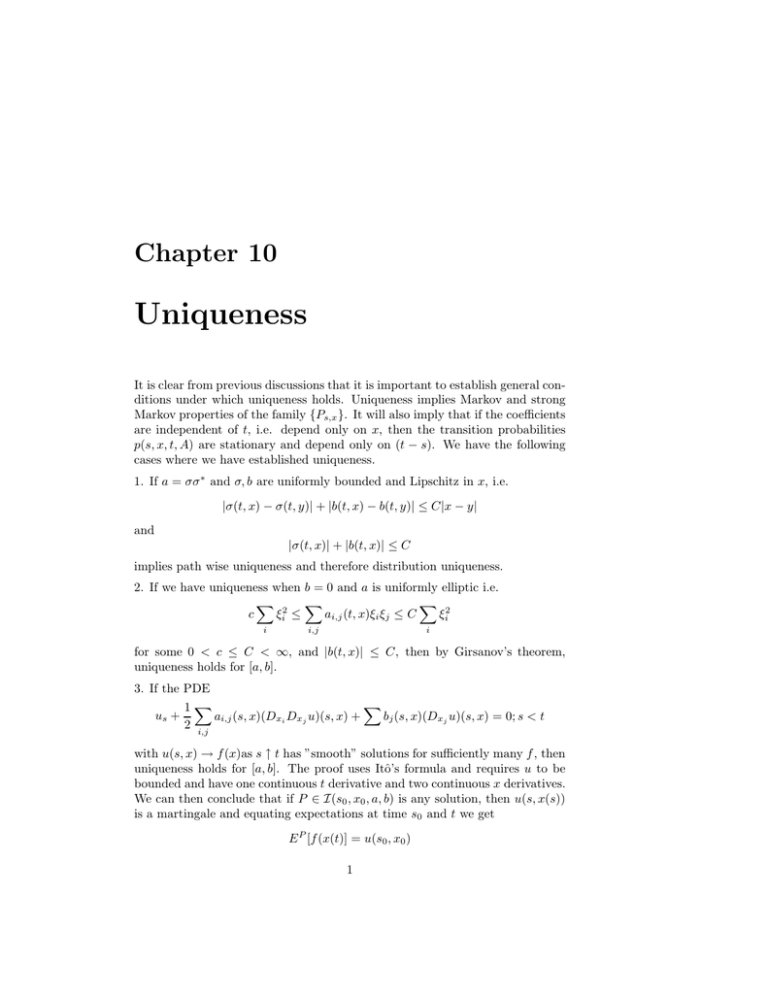Uniqueness Chapter 10
advertisement

Chapter 10
Uniqueness
It is clear from previous discussions that it is important to establish general conditions under which uniqueness holds. Uniqueness implies Markov and strong
Markov properties of the family {Ps,x }. It will also imply that if the coefficients
are independent of t, i.e. depend only on x, then the transition probabilities
p(s, x, t, A) are stationary and depend only on (t − s). We have the following
cases where we have established uniqueness.
1. If a = σσ ∗ and σ, b are uniformly bounded and Lipschitz in x, i.e.
|σ(t, x) − σ(t, y)| + |b(t, x) − b(t, y)| ≤ C|x − y|
and
|σ(t, x)| + |b(t, x)| ≤ C
implies path wise uniqueness and therefore distribution uniqueness.
2. If we have uniqueness when b = 0 and a is uniformly elliptic i.e.
X
X
X
ξi2
ai,j (t, x)ξi ξj ≤ C
ξi2 ≤
c
i
i
i,j
for some 0 < c ≤ C < ∞, and |b(t, x)| ≤ C, then by Girsanov’s theorem,
uniqueness holds for [a, b].
3. If the PDE
X
1X
us +
bj (s, x)(Dxj u)(s, x) = 0; s < t
ai,j (s, x)(Dxi Dxj u)(s, x) +
2 i,j
with u(s, x) → f (x)as s ↑ t has ”smooth” solutions for sufficiently many f , then
uniqueness holds for [a, b]. The proof uses Itô’s formula and requires u to be
bounded and have one continuous t derivative and two continuous x derivatives.
We can then conclude that if P ∈ I(s0 , x0 , a, b) is any solution, then u(s, x(s))
is a martingale and equating expectations at time s0 and t we get
E P [f (x(t)] = u(s0 , x0 )
1
2
CHAPTER 10. UNIQUENESS
If this is valid for any (s0 , x0 ) sufficiently many f , then µs,x,t (A) defined is
defined uniquely by
Z
u(s, x) = f (y)µs,x,t (dy)
From the fact that the conditional probabilities P |Ft are again solutions it
follows that for s < t1 < t2
Ps,x [X(t2 ) ∈ A|Ft1 ] = Pt1 ,x(t1 ) [x(t2 ) ∈ A] = p(t1 , x(t1 ), t2 , A)
proving the Markov property as well as determining the transition probability.
4. In the time homogeneous case one can use the resolvent equation,
λu −
X
1X
bj (x)(Dxj u)(x) = f (x)
ai,j (x)(Dxi Dxj u)(x) +
2 i,j
If u(x) is a bounded twice continuously differentiable solution of the above
equation then by Itô’s formula
Z(t) = e−λt u(x(t)) +
Z
t
f (x(s))ds
0
will be a martingale for any solution Px starting from (0, x). Equating expectations at t = 0 and t = +∞, we get
Z ∞
u(x) =
e−λs E[f (x(s))]ds
0
This will determine uniquely the stationary transition probabilities p(t, x, A) as
Px [x(t) ∈ A] and therefore the entire process.
5. We can try and solve the parabolic equation
us +
X
1X
bj (s, x)(Dxj u)(s, x) + f (s, x); s < t
ai,j (s, x)(Dxi Dxj u)(s, x) +
2 i,j
and u(t, x) = 0. If we have a classical solution then
Z s
f (v, x(v))dv
u(s, x(s)) +
s0
is a martingale and we get
Z t
f (s, x(s))ds]
u(s0 , x0 ) = E[
s0
If we can claim this for sufficiently many functions that would prove uniqueness
as well.
3
6. Finally if we can show that these solutions exist in some generalized sense,
then we can still succeed in proving uniqueness provided we can show, by apriori
estimates, that objects like
Z t
f (s, x(s))ds]
Λ(f ) = E[
s0
are in the appropriate dual space.





